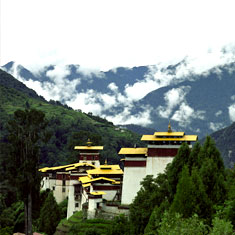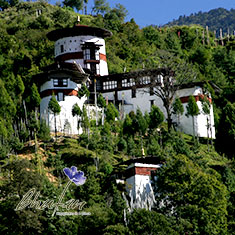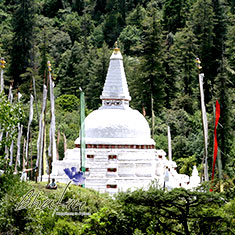
Trongsa
Pelela pass at 3300m is an important dividing range that separates Western Bhutan from Central and Eastern Bhutan. After crossing this important Pass you will enter Trongsa, the sacred and the temporal heart of the country. It covers an area of about 1807 km2 with a total population of 13,428. Agriculture is the main source of income for the people here. Trongsa is historically and ecologically important and fragile dzongkhag in the kingdom. It’s a sleepy and pleasant town, lined with traditional whitewashed shops decorated with pot plants.

Trongsa Dzong
Trongsa Dzong, meaning “The Dzong on the tip of a Dungkhar (Conch) of the never-changing country of Druk and the everlasting Dharma” was built in 1648, it was the seat of power over central and eastern Bhutan. Both the first and second kings of Bhutan ruled the country from this ancient seat.
All four kings were invested as Trongsa Penlop (“governor”) prior to ascending the throne. The dzong is a massive structure with many levels, sloping down the contours of the ridge on which it is built. Because of the dzong’s highly strategic position, on the only connecting route between east and west, the Trongsa Penlop was able to control effectively the whole of the central and eastern regions of the country from here.
It is built on a strategic location overlooking the Mangde chhu (river).

Ta Dzong
This watchtower, which once guarded Trongsa Dzong from internal rebellion, stands impressively and provides visitors and insight into historical significance of Trongsa in Bhutan’s history. It has four observation points resembling Tiger, Lion, Garuda, and Dragon.
This watchtower (ta dzong) overlooking the dzong now houses an excellent museum. The five floors of displays focus on Buddhist art and royal memorabilia, including such varied treasures as the 500-year-old jacket of Ngagi Wangchuk and the football boots used by the teenaged fourth king. You can drive here or walk up a steep staircase from town.
The most sacred religious item is a copy of the Padma Kathang, a biography of Guru Rinpoche written by his consort Yeshe Tsogyel. There are two lhakhangs inside the Ta Dzong; the Gesar Lhakhang is dedicated to the 19th-century penlop of Trongsa, Jigme Namgyal.

Chendebji Chorten
The Chorten, built in the style of the great Bodhanath Chöten of Nepal, was constructed by Tshering Wangchuk son of Yon-Say and the Mahasiddha Zhidag in accordance with the prophecy of the Second Gangteng Tulku Tenzin Lekpai Dhundrup in order to subdue harmful, anti religious demons. It is located 41 km west of Trongsa in Bhutan at 2430 meters in elevation.
A Sambha Lhundrup Molam Chenmo festival is held there annually from the 21st to the 25th day of the 9th lunar month of the Bhutanese calendar.


